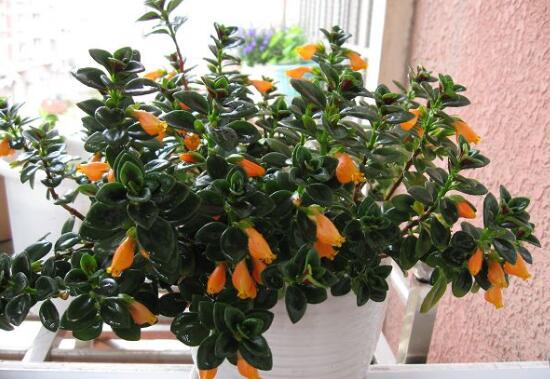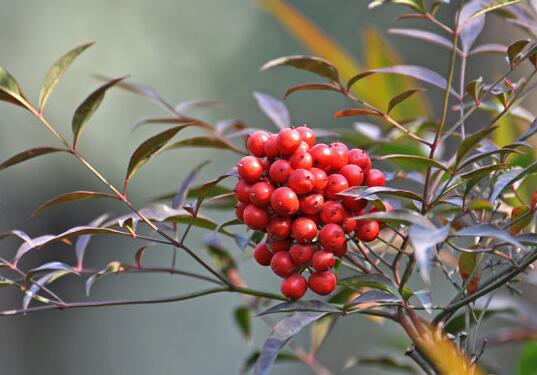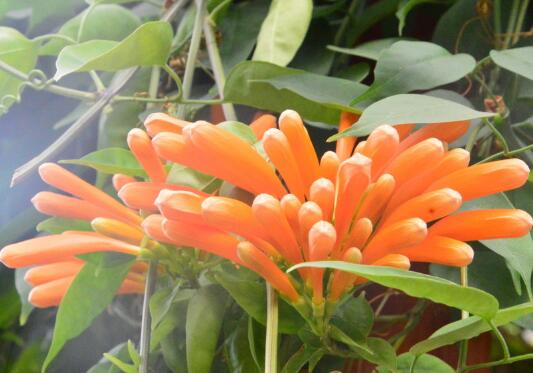How to raise goldfish orchids, the culture methods and matters needing attention / avoid bright light
For goldfish hanging orchid, friends who have seen it should be impressed. It is shaped like goldfish, with rich colors, especially good-looking, and excellent viewing at home. In life, there are many people who want to raise goldfish orchids, so how to raise goldfish orchids? What do you need to pay attention to in the process of breeding? In this regard, the editor carefully sorted out the goldfish hanging orchid culture methods and matters needing attention, very detailed, friends who want to raise must have a look.
First, how to raise goldfish hanging orchids, the method is very important

Goldfish hanging orchid is very beautiful, it has dense branches and leaves, and its stems hang naturally, so it is very suitable for potted plants at home. However, goldfish orchids are not easy to feed, and they have higher requirements for environment, soil, temperature and humidity, so how to raise goldfish orchids? This requires us to have the skill to raise, to put it simply, to master the culture method of goldfish orchid.
II. Culture methods and matters needing attention of goldfish Cymbidium
1. Soil
How to raise goldfish hanging orchids, the first thing is to choose pot soil. Cover the bottom of the flowerpot with coarse grains and stones, and then add a small amount of mixed culture soil. The choice of basin soil is as follows:
Soil: in order to prevent the rotten roots of goldfish, we should choose slightly acidic soil with good ventilation and drainage; flowerpots: in order to prevent water leakage, round and beautiful flowerpots can be used.
2. Lighting
In the goldfish hanging orchid culture method, light is essential. However, goldfish hanging orchid is shade-resistant, suitable for growth under astigmatism and avoid direct light. Therefore, when breeding indoors, in addition to having sufficient light in winter, 60% of the sun should be covered in spring, summer and autumn, or hanging in the outdoor shade shed.
Note: do not let the plant accept direct sunlight, or there will be goldfish hanging orchid leaves yellowing, leaf loss, serious death symptoms. In addition, goldfish hanging orchid in winter before flowering, should appropriately enhance the light, so as to make its flowers colorful.
3. Temperature
How to raise goldfish hanging orchids, the appropriate temperature is also very important. When breeding indoors, the temperature should not be too high or too low, and the most suitable temperature is between 15 and 20 ℃.
Note: goldfish hanging orchid avoid low temperature, but also avoid high temperature, too low or too high temperature will make goldfish hanging orchid lose its leaves.
4. Watering
In the process of goldfish culture, watering is a very important link. In spring, summer and autumn, to keep the basin soil moist, dry and wet; in winter, goldfish orchids enter the dormant period, when the growth is slow, it is necessary to reduce the amount of water and keep it dry until the flower buds appear.
Note: goldfish hanging orchids like the wet environment, but we should pay attention to watering, not too much water, otherwise it is easy to rot the roots.
5. Humidity
In addition to watering, in the goldfish hanging orchid culture method, humidity is also need to pay attention to. If the air is too dry, spray a layer of water on the surface of the goldfish orchid leaves to maintain humidity, so that the leaves will be fuller and greener.
Note: usually to maintain environmental humidity, it is best to often spray water around the flowerpot; if you do not have time to take care of it, you can put the flowerpot in a shallow pot with clear water, so as to effectively ensure a small range of environmental humidity.
6. Fertilization
How to raise goldfish hanging orchids? after watering, let's take a look at the fertilization requirements. Goldfish flowers do not require much fertilizer and water, just apply thin organic fertilizer every half a month or so. Fertilization is mainly in spring and autumn, and rarefied liquid fertilizer is applied every 10-14 days.
Note: in order to bloom beautiful flowers, the goldfish orchid should be fertilized during the flowering period. In addition, liquid fertilizer is mainly applied with nitrogen fertilizer in autumn to promote luxuriant branches and leaves; more fertilizers containing more phosphorus and potassium should be applied in spring to make the flowers colorful.
7. Pruning
If you want to raise goldfish hanging orchids, in addition to the above points, proper pruning is also very important. After the goldfish orchid has withered, all weak branches, top branches and overlong drooping branches should be cut off; at the beginning of winter, the withered flower stems should be cut off from the base and kept dry, so as to facilitate the germination and growth of new flower branches in the next spring.
How to raise goldfish orchids? what's the difference between goldfish orchids and goldfish orchids?
Goldfish hanging orchid, also known as kangaroo flower, its leaves are dark green, the leaves are relatively thick. Orange-red flowers, small mouth, big belly, the shape is very similar to goldfish, so named goldfish hanging orchid, from a distance like goldfish leisurely roaming in the green water plants, very interesting and lasting, to add a touch of lovely green to the home.
The culture method is similar to that of Cymbidium, but there is a slight difference, which requires special attention.
1. The substrate soil mixed with rotten leaf soil, stable manure and sand according to the ratio of 3 ∶ 1 ∶ 1, the pH value is 6 ~ 6.5. The thin compound fertilizer solution was applied every month, and the phosphorus and potassium fertilizer solution was applied every half month two months before flowering. Change the basin every other year.
2. The suitable temperature for growth is from 16 ℃ to 28 ℃. When the temperature is above 30 ℃, shading and ventilation should be strengthened, otherwise there will be fallen leaves, and the overwintering will be maintained at least 10 ℃.
3, shade-resistant, suitable for scattered light, avoid strong light. When the basin soil surface is dry, it can often spray water to the leaf surface and around the plant to enhance the air humidity and reduce watering in winter.
4. All weak branches, top branches and overlong drooping branches should be pruned after flowering, and the withered flower stems should be cut off from the base at the beginning of winter and kept dry, which is beneficial to the germination and growth of new flower branches in the next spring.
5, mainly by cutting propagation, can cut branches with nodes, each section of about 8 cm, the upper leaves cut off half, the lower all cut off, to maintain a semi-shady humid environment, about 30 days can take root on the basin. It can also be propagated in early spring or late autumn with 1 to 2 terminal buds per clump and 2 to 3 plants per pot.
Goldfish hanging orchid is very easy to survive, not very picky living environment, give it some sunshine, it will bloom a beautiful smiling face for you.
Methods of culturing goldfish flower matters needing attention in culturing goldfish flower
Goldfish flower, that is, we often say goldfish hanging orchid, people usually regard it as a family hanging appreciation, so, what are its breeding methods? What do we need to pay attention to in the process of cultivating goldfish flowers? Next, the editor of Fuwo Decoration Network will give you a brief introduction to the breeding methods of goldfish flowers. To apply fertilizer:
Goldfish flowers do not require much fertilizer and water, just apply thin organic fertilizer and water every half a month or so. If you can increase some phosphate fertilizer before budding, you can blossom more and be colorful. Fertilization is mainly in spring and autumn, and dilute liquid fertilizer is applied every 10-14 days. Liquid fertilizer is mainly applied with nitrogen fertilizer in autumn to promote luxuriant branches and leaves, while more fertilizers containing phosphorus and potassium should be applied after spring to make the flowers colorful.
Watering points: goldfish flowers have more requirements for water in the vigorous growing season, and keep the basin soil moist in spring, summer and autumn, so that "see dry and wet". Usually to maintain environmental humidity, it is best to often spray water around the flowerpot, but to avoid wetting the leaves. If you don't have time to take care of it, you can put the flowerpot in a shallow pot filled with clear water, which can effectively ensure a small range of environmental humidity. After entering winter, goldfish flowers enter the dormant period and grow slowly, so it is necessary to reduce the amount of water and keep them dry until the buds appear. After seeing the bud, you can appropriately increase the amount of water to prepare for flowering. Pruning essentials: all weak branches, top branches and overlong drooping branches should be pruned after flowering, cut off from the base of the withered flower stem in winter, and keep dry, which is beneficial to the germination and growth of new flower branches in the next spring.
Main points of reproduction:
Goldfish flower can be propagated by top branch cutting or stem cutting. It can be carried out all year round, and it is best to do it indoors after flowering. Cut the annual branch treaty 10~15cm, retain 3mur4 leaves, remove the basal pairs of leaflets, and insert them into the sand. Cover with glass or plastic film, control the temperature at 20 ℃, and maintain high air humidity. Rooting can be achieved in about 3 to 4 weeks. Two months after survival, the heart is removed to promote more branches, to facilitate more flowers, and then it can be planted on the pot. The seedlings did not bloom in the first year, and red flowers spit out in the axils of the leaves at the end of the weeping branches after 2023. Goldfish flower can be propagated by sowing, ramet and cutting. Because the seeds are not easy to obtain, most of them do not use sowing and propagation, and cutting methods are commonly used to propagate. In spring and autumn, about 10 cm (4 nodes) of branches were cut and inserted into a bed made of river sand or vermiculite to maintain high humidity. It can take root in about a month when the temperature is 20Mel and 25 ℃. After rooting and surviving, it can strengthen management, promote the growth of new branches, and carry out coring to promote branching. After 1 Mel for 2 months, it can be planted in the pot. Goldfish flower culture method (basic knowledge): the best breeding time: top branch cutting or stem cutting method, which can be carried out throughout the year. The cutting method is carried out in spring and autumn. The best growing soil: goldfish flower generally requires that the substrate is rich in humus, loose and well drained. Growth humidity requirements: goldfish flowers in the growing period to have sufficient moisture, basin soil should always keep wet, and try to improve air humidity. The optimum growth temperature of goldfish flower is 18-22 ℃, and low temperature is avoided.
The best growth light: goldfish flower is shade-resistant, suitable for scattered light, avoid strong light.
- Prev

Is Phyllostachys pubescens poisonous? can Phyllostachys pubescens be cultured indoors / poisonous but can be raised indoors
Phyllostachys pubescens is a kind of highly ornamental plant, and its plant shape is beautiful, so it is loved by many people. Many people want to raise this kind of plant at home, but many plants are toxic to a certain extent. Before breeding, this should be made clear. So is Phyllostachys pubescens toxic? Can Phyllostachys pubescens be cultured indoors
- Next

How to raise potted firecracker flowers, culture methods and precautions / regular pruning
Firecracker flower is a kind of flower native to South America, which was introduced to China, and now it is quite common in our country. There are many things to pay attention to when raising this kind of flower, so how to raise it in pot? What are the culture methods and matters needing attention of firecrackers?
Related
- Fuxing push coffee new agricultural production and marketing class: lack of small-scale processing plants
- Jujube rice field leisure farm deep ploughing Yilan for five years to create a space for organic food and play
- Nongyu Farm-A trial of organic papaya for brave women with advanced technology
- Four points for attention in the prevention and control of diseases and insect pests of edible fungi
- How to add nutrient solution to Edible Fungi
- Is there any good way to control edible fungus mites?
- Open Inoculation Technology of Edible Fungi
- Is there any clever way to use fertilizer for edible fungus in winter?
- What agents are used to kill the pathogens of edible fungi in the mushroom shed?
- Rapid drying of Edible Fungi

